
The rocks of Mendip
Silurian | Devonian | Lower Carboniferous | Upper Carboniferous | Triassic | Lower to Middle Jurassic
Lower Carboniferous rocks (359 to 327 million years ago)
At the beginning of the Carboniferous the arid terrestrial environment of the Devonian gave way to shallow marine conditions. The Mendip area became part of a broad, southward shelving, shallow tropical sea that stretched from Belgium westwards into Pembrokeshire. The initial flooding of the region produced the mud-rich Avon Group (Lower Limestone Shale), followed by a succession of coral-rich limestones comprising (in ascending order): the Black Rock Limestone, Burrington Oolite and Vallis Limestone, Clifton Down Limestone and Oxwich Head Limestone. It is these limestones that form the dominant features of the Mendip landscape.
Avon Group (Lower Limestone Shale)
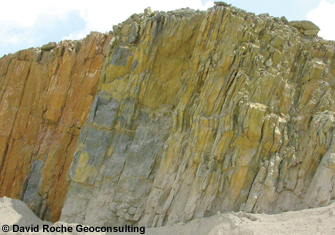
The Avon Group (or Lower Limestone Shale), is up to 150 m thick in the western Mendips. The dominant lithology is fissile mudstone with limestone interbeds. The mud-rich nature of the succession reflects the environmental transition from arid desert to shallow sea. Conditions were too turbid to allow the growth of corals, which are a feature of much of the lower Carboniferous succession, but other marine fossils such as crinoids, brachiopods and bryozoans became well-established and are a significant component of limestones in the lower part of the succession, including a marker-horizon known as the 'Bryozoa Bed'. Ripples, scours and cross-bedding in the limestones show that deposition occurred in a shallow, high energy environment, and some of the limestones are distinctly reddened due to high concentrations of the iron mineral haematite. The higher part of the formation contains greenish-grey shales and black crinoidal limestones, which were probably deposited in a slightly more open-water marine setting.
Black Rock Limestone Subgroup
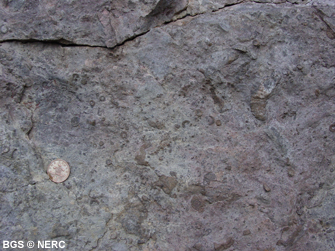
The Black Rock Limestone predominantly comprises dark grey or black limestone with abundant crinoid remains, and varies from c. 250 m thick in the western Mendips to 370 m in the east. Thin shaly beds occur in the lower and middle parts of the succession and there are two intervals characterised by sheets and nodules of chert, c. 30 m and c. 150 m above the base of the unit; the upper interval is the thickest and most widely developed. Parts of the Black Rock Limestone have been altered to dolomite during burial of the succession; a process known as dolomitisation. This process involves the replacement of some of the calcium in the limestone by magnesium. The Black Rock Limestone is the most fossiliferous part of the lower Carboniferous succession in the Mendips. Apart from crinoids, corals and brachiopods are especially common, and different varieties of these occur at different levels through the formation.
Burrington Oolite Subgroup and Vallis Vale Limestone Formation
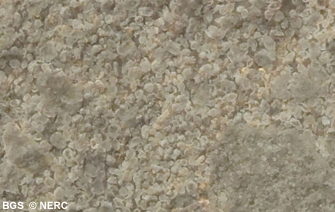
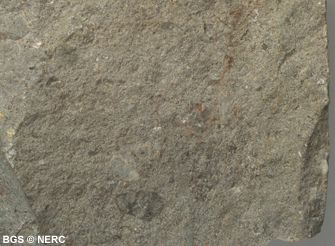
Massive-bedded oolitic limestone is the characteristic lithology of the Burrington Oolite, which is up to c. 230 m thick in the Wells area, and typically 180–210 m thick over the rest of the Mendip district. Ooliths, of which the limestone is predominantly comprised, are small rounded grains with a concentrically layered cross-section. These grew by accretion of carbonate in shallow, high energy, marine environments. The limestone is typically pale grey and cross-bedded, but includes some beds of much coarser crinoidal limestone in its lower part, and units of pale grey lime mudstone in its upper part. There are two conspicuous beds of dolomitic mudstone in the succession, the Ham Mudstone (6 m above the base) and the Rib Mudstone (38 m below the top). The Burrington Oolite becomes less oolitic and increasingly dominated by coarse-grained crinoidal limestone southwards and eastwards towards the eastern Mendips. This crinoidal limestone replaces the Burrington Oolite from the base upwards and is named the Vallis Vale Limestone Formation; it is more than 150 m thick in the Binegar-Ashwick area, and completely replaces the Burrington Oolite further east near Mells and Whatley. Northwards, in the Bristol district, the Burrington Oolite is represented by a mixed succession of oolitic and near-shore lagoonal carbonate mudstone lithologies.
Clifton Down Limestone Formation
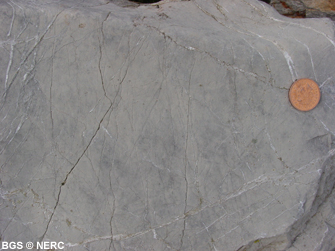
The lithology is dominated by calcite mudstones with a locally abundant but low diversity fossil assemblage. At Burrington Combe the formation is about 170 m thick, and three subdivisions can generally be recognised across the Mendip area. The lowest unit comprises a mixture of calcite mudstones, white oolitic limestones and dark splintery limestones. This interval is relatively expanded in the Cheddar area, where a 38 m thick dark limestone ('Cheddar Limestone Member') is overlain by a 58 m thick white oolitic limestone ('Cheddar Oolite Member'). The middle part of the succession is dominated by fine-grained, grey-black limestone with nodules and bands of chert and abundant remains of the coral Siphonodendron ['Lithostrotion'] martini ('Lithostrotion Limestone'). Porcellaneous calcite mudstones dominate the highest part of the formation, including locally developed algal mudstones and stromatolites, indicating deposition in a very shallow-water, near-shore or lagoonal environment.
Oxwich Head Limestone Formation (Hotwells Limestone)
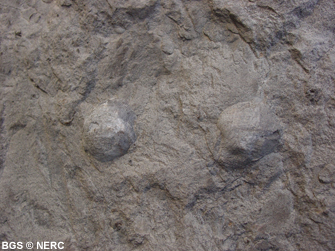
This formation, formerly known as the Hotwells Limestone, is characterised by massive grey crinoidal and oolitic limestone with an abundant fauna of corals and thick-shelled brachiopods. The thickness varies from 125 m to about 230 m, with a general increase in a north-easterly direction across the Mendip area. The lithology marks an abrupt environmental change from the low energy, near-shore depositional setting in which the fine-grained upper part of the Clifton Down Limestone was deposited, to a high energy, open marine shelf. Some 20 m above the base of the formation in the Cheddar–Westbury area there is a 3 m interval containing seams and nodules of chert, which forms a useful marker-horizon. The upper part of the formation is more variable in lithology, comprising rubbly limestones, dolomitic limestones, thin sandstones and fissile mudstones. North of the Mendips, sandstones progressively replace the upper part of the Oxwich Head Limestone, reflecting the progression of land-derived sediment into the shallow sea.
- Home
- Overview maps
- Locality
areas
- Cheddar Gorge
- Charterhouse
- Blackdown
- Burrington Combe
- Shipham & Rowberrow
- Crook Peak & Axbridge
- Banwell to Churchill
- Priddy
- Harptree & Smitham Hill
- Draycott & Westbury-sub-Mendip
- Wookey Hole & Ebbor Gorge
- Wells
- Great Elm & Vallis Vale
- Mells & the Wadbury Valley
- The Vobster area
- The Whatley area
- Torr Works & Asham Wood
- Beacon Hill
- Stoke St Michael & Oakhill
- Holwell & Nunney
- Shepton Mallet & Maesbury
- Gurney Slade & Emborough
- The Nettlebridge valley
- Geology
- Minerals and mines
- Quarrying
- Caves and karst
- Biodiversity
- Detailed site information
- Acknowledgements
- External links
- Search
- Site map